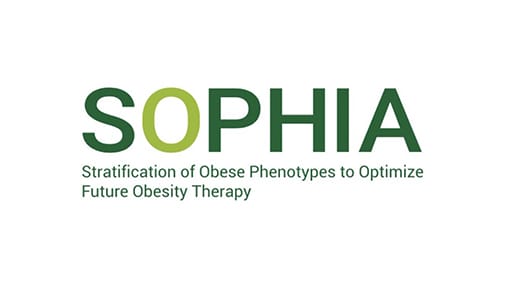
IMI Sophia
About IMI-SOPHIA IMI-SOPHIA (Stratification of Obesity Phenotypes to Optimise Future Obesity Therapy), is a Public-Private Partnership funded by the Innovative Medicines Initiative (IMI) in collaboration with the European Commission]. The project aims to revolutionise obesity care by delivering evidence-based insights across the healthcare system to redefine obesity treatment pathways and optimise future treatment.
The overall goal of SOPHIA is to better understand an individual’s risk and the overall health impact so that care can be personalised and prioritised. The project involves various initiatives such as:
- Changing attitudes and perspectives surrounding obesity to build a common understanding
- Creation of a federated database.
- Using obesity phenotypes to identify obesity risks and responses to treatment.
- Mapping opportunities for improved healthcare delivery and policy, transforming research into action.
The project brings together healthcare professionals, academia, industry leaders, and patient organisations to change the future of obesity care.
The challenge
Work Package 8 of IMI-SOPHIA was tasked with changing the narrative around obesity and providing concrete tools and frameworks to improve health service delivery.
Our research first had to identify the specific challenges facing key stakeholder groups. Healthcare professionals required better education and training on obesity management, while patients needed personalized treatment plans and empathetic healthcare interactions. Researchers sought more funding and collaboration opportunities, and policymakers needed evidence-based policies and public awareness campaigns. Media representatives aimed for accurate reporting, and healthcare providers looked for cost-effective treatment options. Pharmaceutical industries focused on innovative treatments and regulatory support.
These insights were gathered through interviews, focus groups, and surveys to ensure a comprehensive understanding of the diverse needs and challenges in obesity treatment and management.
Solution
The Blueprint for Change is the final major deliverable for WP8 and is a culmination of the other precursors. It is crucial because it provides a comprehensive, evidence-based approach to redefining obesity care.
By implementing these guidelines on “readiness to act”, healthcare systems can improve early detection and intervention, personalise treatment plans, and enhance patient outcomes. The proactive engagement and communication strategies foster a supportive environment for patients, while the data repository and resilience testing ensure that the guidelines are effective and adaptable in real-world settings. Ultimately, the Blueprint aims to transform obesity care, making it more efficient, effective, and patient-centred, which is essential for addressing the growing obesity epidemic and its associated health challenges.
The Blueprint for Change aligns with international health policies and frameworks, incorporating guidelines and recommendations from leading health organisations such as the World Health Organization (WHO) and the European Commission. It also supports health system resilience by ensuring that healthcare providers can adapt to changing circumstances and continue to deliver high-quality care.
Additionally, the Blueprint is grounded in value-based healthcare principles, which focus on providing the best patient experience, advancing health equity, improving patients’ health outcomes, delivering healthcare services at a reasonable cost, and supporting the well-being of the healthcare workforce. By aligning incentives and payment with patient outcomes, this approach promotes better coordination among healthcare professionals, reduces redundancies, and expands access for historically marginalised or clinically complex populations.
Here are some key points from the document:
- Guidelines for Obesity Screening: The blueprint includes detailed guidelines for obesity screening, which should be conducted routinely every two years for adults. This frequency is essential to monitor key health indicators related to obesity, allowing early detection and timely intervention if risk factors are identified. Screenings should be accessible through multiple healthcare points to maximise reach and engagement.
- Obesity Screening Metrics: The screening process starts with an initial evaluation of an individual’s Body Mass Index (BMI). If the BMI is greater than 25, the individual proceeds to a comprehensive screening assessment. This includes an in-depth analysis of various metabolic and anthropometric indicators such as fasting glucose levels, lipid metabolism, blood pressure, serum creatinine, alanine transaminase, C-reactive protein, and fat distribution.
- Referral after Screening: Individuals identified as at-risk through the IMI-SOPHIA Risk Stratification Algorithm should be referred for a possible early obesity diagnosis.
- Proactive Engagement and Communication: Healthcare professionals play a critical role in screening obesity through proactive, sensitive communication. It is essential for providers to initiate respectful, constructive conversations about obesity, approaching the topic in a non-judgmental and supportive way.
- Data Repository and Requirements: To facilitate data-driven research and policy development, healthcare providers should be encouraged or even required to collect and submit de-identified metabolic and anthropometric measurements from routine screenings to a national centralised obesity database.
- Resilience Testing: The blueprint also includes resilience testing for obesity screening implementation to ensure the guidelines are robust and effective in real-world settings.
- IMI-SOPHIA Risk Stratification Algorithm: This algorithm plays a critical role in the Blueprint by providing a sophisticated tool for assessing and stratifying obesity-related health risks. It helps healthcare providers tailor interventions to individual patient needs, improving the precision and effectiveness of care.
Data Privacy: Data privacy is ensured through strict adherence to data protection regulations, use of secure data storage and transmission protocols, and implementation of robust data governance frameworks. Stakeholder trust and compliance with ethical standards are paramount in the Blueprint’s implementation.
Impact
This project is ongoing. We are delighted to already have two Q1 peer reviewed publications as well as the ISPOR Europe 2024 prize for best abstract presentation as well as be in the top 5% of abstracts voted by an expert jury.
